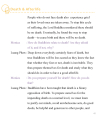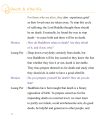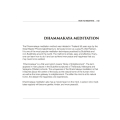non-Buddhists : ค้นหาหนังสือธรรมะ หน้า 2 / 15
หน้าหนังสือทั้งหมด

175
Training Oneself in Non-Recklessness by Practicing Austerity
Chapter 40
Training Oneself in Non-Recklessness by Practicing Austerity (Dhütanga) 4
Life is full of uncertainties and danger awaits those who are reckless with their lives. The Lord Buddha once sa
Chapter 40 emphasizes the significance of non-recklessness through the practice of austerity as taught by the Lord Buddha. It highlights that life is filled with uncertainties and that reckless behavi

63
Understanding Paccekabuddhas in Buddhist Philosophy
V. Reference 2: Dhammakāya and Paccekabuddhas
A Paccekabuddha is counted as one of the two types of Buddhas. According to Buddhist philosophy, a Paccekabuddha is a person who is of the highest wisdom
This text discusses the concept of Paccekabuddhas, individuals of high wisdom who achieve self-enlightenment but lack the ability to teach. It explores scholarly arguments about the pre-Buddhist origi

67
Dhammakaya Foundation's Role in Promoting Peace
United Nations: Non Governmental Organizations
Since August 1986 the Dhammakaya Foundation has become the United Nations - accredited Non-Governmental Organisation associated with the Department of P
The Dhammakaya Foundation has been a UN-accredited NGO since August 1986, actively participating in various peace initiatives, including the Millennium People's Assembly and the International Year for

54
The Story of Culasubhadda
4
The Story of Culasubhadda
While residing at the Jetavana monastery, the Buddha uttered Verse (5) of this chapter, with reference to Culasubhadda the daughter of Anathapindika.
Anathapindika and U
The story revolves around Culasubhadda, the daughter of Anathapindika, who faced challenges in her marriage due to her parents-in-law's non-Buddhist beliefs. Living in the house of Ugga's family, she

39
Death & Afterlife in Buddhism
Death & Afterlife
Monica
People who do not face death also experience grief
as their loved ones are taken away. To stop this cycle
of suffering, the Lord Buddha considered there should
be no death. Ev
บทความนี้สำรวจความเชื่อของพุทธศาสนาเกี่ยวกับความตายและชีวิตหลังความตาย โดยเน้นความจริงที่ว่า แม้ทุกคนจะกลัวความตาย แต่พุทธศาสนิกชนจะมีแนวทางเตรียมตัวด้วยการทำความดี และปฏิบัติตนอย่างเหมาะสมเพื่อเตรียม

182
Characteristics of a True Buddhist
are like any of them and if we have performed our duties as
true Buddhists yet or not.
A true Buddhist must exhibit the following
characteristics:
1) Belief in the Lord Buddha's Enlightenment. It is
t
This text examines the qualities necessary for being a true Buddhist, highlighting the importance of belief in the Lord Buddha's Enlightenment, adherence to the 5 precepts, understanding of Kamma, and

40
Death & Afterlife in Buddhism
Death & Afterlife
Monica
Luang Por
Monica
Luang Por
40
For those who are alive, they also experience grief
as their loved ones are taken away. To stop this cycle
of suffering, the Lord Buddha thought
เนื้อหานี้กล่าวถึงวิธีที่พุทธศาสนิกชนรับมือกับความตาย โดยพูดถึงความกลัวที่มีอยู่ในตัว ทุกคนล้วนกลัวความตาย แต่พุทธศาสนิกชนแท้จริงเข้าถึงความตายได้ดีกว่าเพราะรู้ว่าเป็นสิ่งที่หลีกเลี่ยงไม่ได้ การเตรียม

197
Understanding the Wisdom of the Lord Buddha
Since we must seek refuge in our own wisdom in times
of sorrow and happiness, we can appreciate that the Lord
Buddha's supreme wisdom (of how to lead one's life) is indeed
comparable to none. His pure
This text emphasizes the supreme wisdom of the Lord Buddha, which serves as a guide in both sorrow and joy. It highlights the causes of life's vicissitudes, including the Law of Cause and Effect (Kamm

147
การเจริญสติวิธีธรรมกาย
…Luang Pu Wat Paknam. It is one of the most popular meditation techniques practiced by Buddhists and non-Buddhists around the world. The method is simple, easy, and effective. Everyone can learn how to do it and ca…
การทำสมาธิธรรมกายเริ่มขึ้นในประเทศไทยเมื่อ 96 ปีที่แล้ว โดยพระมหากษัตริย์พระธรรมกายซึ่งเป็นที่รู้จักกันดีในนามหลวงปู่วัดปากน้ำ เป็นเทคนิคการทำสมาธิที่ได้รับความนิยมทั้งในหมู่ชาวพุทธและไม่ใช่ชาวพุทธทั่

119
How to Meditate: The Dhammakaya Method
…Luang Pu Wat Paknam.
It is one of the most popular meditation techniques practiced by Buddhists and non-Buddhists around the world. The method is simple, easy, and effective. Everyone can learn how to do it and ca…
The Dhammakaya meditation method, initiated by Phra Mongkhalpemnu in Thailand 60 years ago, is popular worldwide for its simplicity and effectiveness. This method focuses on the 'body of enlightenment

7
Understanding the Mind in Thai Culture
"this or that", "black or white", with no gray area, as the
locals find this logic easy to grasp and put into practice. In
addition, Thai culture and language has a relatively large
amount of words an
This text discusses the simplicity of dualistic thinking in Thai culture and the rich linguistic resources that explain human cognition. It emphasizes that terms often linked to Buddhism should be tre

203
The Merits of Contributing to Buddha Images
Here is the extracted text from the image:
---
Those who are not born during the life of a Buddha must seek refuge in the Lord Buddha’s teachings, unaware of His appearance.
Our country’s ancestors
Those not born during Buddha's time must seek refuge in His teachings. Our ancestors, through meditation, recreated His image in Buddha statues, enriching our faith and spiritual knowledge. Contributi

69
Success of Moral Training Projects: Dhammadayada Program
ASE HISTORY OF THE SUCCESS OF MORAL TRAINING PROJECTS
The Dnammadayada (Dhamma Inheritors) Training Programme has been conducted for twenty-seven years since the beginning of the Dhammikaya Foundatio
The Dhammadayada Training Programme has operated for twenty-seven years, focusing on hands-on Buddhist practice for students. In 1996, the program was scientifically assessed, revealing that participa

34
Understanding the Three Characteristics of Existence
When we receive fortune, prestige, recognition or happiness,
our minds will remain calm, not overwhelmed or attached.
A person who is aware of suffering and happiness has
trained the mind to be as sta
This text elaborates on the Three Characteristics: impermanence, suffering, and non-self, as fundamental truths of existence in Buddhism. It highlights how fortune, prestige, and happiness are tempora

175
Training Oneself in Non-Recklessness through Austerity
Chapter 40
Training Oneself in Non-Recklessness by
Practicing Austerity (Dhutanga)"
Life is full of uncertainties and danger awaits those who
are reckless with their lives. The Lord Buddha once said,
本章探讨了如何通过修行苦行来培养非轻率的心态。佛陀教导说,轻率的人就像死去的人。通过苦行,人们可以学习更加小心翼翼地生活。佛陀在传播法教过程中,总共给予了84000个教导,其核心在于非轻率,这是他在入涅槃前对弟子们的最终教诲。

176
The Importance of Carefulness in Buddhism
"Bhikkhus," my duties that are of benefit and support to
you are now complete. I now wish to remind you that the
nature of all living creatures is impermanence and
degeneration. Thus, you should conti
In Buddhism, carefulness is essential for maintaining virtue and reducing the chances of misconduct. As beings with limited lifespans, it is vital to perform wholesome actions. The state of mind influ

36
Golden Age of Inner Peace
36
36
Golden Age of Inner Peace
of life. Although the late Mr. Alfred Nobel left this
world many decades ago, his great vision and his
much admired work live on to this day because of
the Nobel family
The late Alfred Nobel's vision lives on through the ongoing work of the Nobel family and the Nobel Foundation, symbolizing achievements in peace and humanity. The Dhammakaya Temple and Foundation expr

130
Systematic Training Programme for Spreading Buddhism
The Systematic Training Programme for Spreading Buddhism began in 1999-2007, with a total of 71 classes completing the Programme. There have been 8.090 monks from 5.833 temples, from across the countr
The Systematic Training Programme for Spreading Buddhism, initiated from 1999 to 2007, has successfully trained 8,090 monks from 5,833 temples across Thailand, promoting the teachings of the Buddha. T

6
The Teachings of Luang Phaw Dhammajayo
immersing himself in the study and practice of the
Buddha's pure teachings. For almost 40 years, he
has always emphasized to the thousands of those
who follow his teachings at the Dhammakaya
Temple, b
Luang Phaw Dhammajayo has dedicated nearly 40 years to promoting the Buddha's teachings, asserting that true world peace originates from inner peace. He emphasizes everyone's role in enhancing humanit

34
Understanding the Three Characteristics of Existence
When we receive fortune, prestige, recognition or happiness,
our minds will remain calm, not overwhelmed or attached.
A person who is aware of suffering and happiness has
trained the mind to be as s
This text discusses the importance of understanding the Three Characteristics of existence: Impermanence, Suffering, and Non-self. It emphasizes that fortune, prestige, and happiness are temporary and
